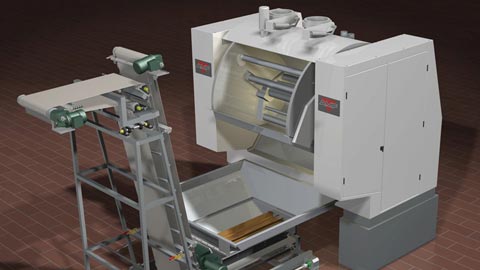Virtual assemblies reveal design errors prior to production for bakery equipment manufacturer
Virtual assemblies reveal design errors prior to production for bakery equipment manufacturer

Case Study
Mixing client satisfaction with profitability
AMF Canada
Bakery equipment manufacturer shrinks design time and reduces rework to meet delivery dates without overtime costs
A mixture of requirements
AMF Canada designs and manufactures the complete line of baking equipment from mixers and make-up equipment to slicers, baggers and post-packaging solutions as well as washing machines for the bottle industry. Much of its equipment is customized and under contract to be delivered by a certain date. This puts product design on the critical path for profitability. “When designs have errors, that can delay delivery because some amount of rework is usually required,” explains Marc Stringer, the company’s CAD coordinator. Because missing a delivery date might cause a client to look elsewhere the next time for its baking equipment, management often authorized overtime, cutting into the profitability of the project.
With the goal of reducing design errors, AMF Canada decided to upgrade from 2D AutoCAD to solid modeling. Its first attempt, buying a few licenses of SolidWorks, was unsuccessful. “I don’t know why but they just sat on the shelf,” says Stringer, who was not with the company at the time. “To my knowledge, not a single piece of equipment was designed with that software.” Stringer was hired at AMF Canada to make 3D happen so he decided to look into other solid modeling options. In particular he was looking for a program that would be easy to use and also would allow a gradual move into 3D. The flexibility to move slowly into 3D was important because the company had a great deal of legacy AutoCAD data it wanted to continue to use. Also, it had done some customization with macros to streamline the transfer of information from drawings to bills of material to the company’s MRP system. It was important not to lose that work.
Recipe for solid modeling success
The system that best met AMF Canada’s requirements was Solid Edge® 3D CAD from Siemens Digital Industries Software. Its ease of use ensured that it wouldn’t sit on a shelf. Indeed, after a five-day training program conducted by the reseller (Automadesign of Bromont, Quebec), designers were fully productive. Not only that, they were very happy to have the new capabilities. “They saw going to 3D as a blessing,” Stringer says.
The reputation and stability of Siemens was a factor in AMF Canada’s selection of Solid Edge, as was the support of Automadesign. In addition to providing training, the reseller helped Stringer set up the design system so that the macros and drawings created with AutoCAD were easily accessible to designers working in Solid Edge. Today all new machines are designed in Solid Edge using a hybrid approach that incorporates legacy 2D and bill of material information whenever applicable.
AMF Canada has 15 licenses of Solid Edge. Designers develop new machines by creating assemblies of solid models in Solid Edge prior to actual physical assembly. Some of their machines are large assemblies, such as a new oven that consisted of around 10,000 parts. The ability to view these complex virtual machines on the screen and rotate them to any angle has made it possible for designers to detect and fix errors prior to having parts made or assembly done. Another advantage is that when drawings are created from accurate solid models, the drawings are accurate as well. And because it is so easy to make drawings in Solid Edge, the shop floor is getting better information. “Drawings are clearer and we can make lots of views,” says Stringer. “The people on the shop floor are finding it easier to understand things.”
The move to 3D is enabling the company to attract talented young people who learned 3D in school. “For mechanical engineering, 2D is out and many new engineers do not want to work with old drawing methods,” Stringer explains. “Solid Edge helps us attract those people.” Experienced engineers, once they are trained in 3D, appreciate the quality of the new working method, which is a source of motivation. As a result, the quality of work and productivity are better than before. “The switch to a 3D environment improves the engineering group’s working tools,” Stringer adds.
